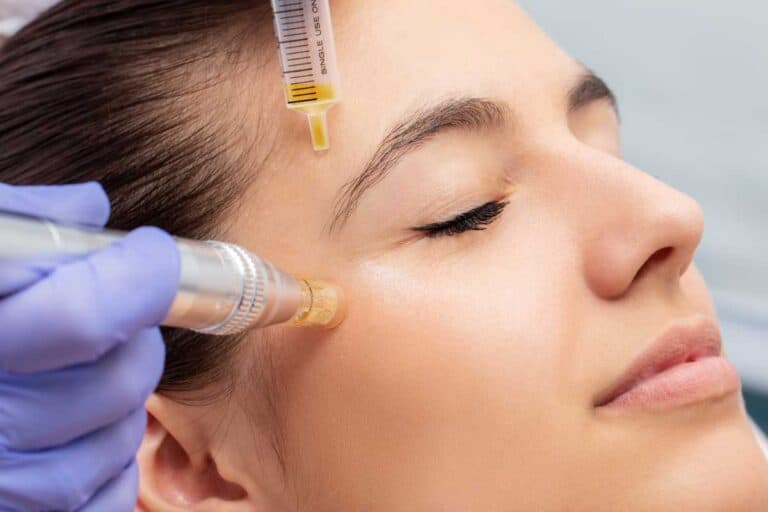Does Vitamin E Reduce Wrinkles? 4 Benefits for Youthful Skin!
Does Vitamin E Reduce Wrinkles? 4 Benefits for Youthful Skin!

Have you ever wondered if there’s a natural solution to reduce the appearance of wrinkles? Many skincare products can help improve skin elasticity and moisturize the skin. Well
As a powerful antioxidant, vitamin E, with its photoprotective effect and high content of tocopherols, has garnered attention for its ability to combat oxidative stress and protect against free radical damage. But did you know that it also holds promise in reducing wrinkles and providing moisturizing benefits for dry skin?
Additionally, it can help improve skin elasticity and provide antioxidants. Research suggests that incorporating antioxidants like vitamin E, specifically tocopherol acetate and tocotrienols, into your skincare routine may have anti-aging properties, making it an effective ingredient for wrinkle reduction.
Personally, I’ve experienced the photoprotective effect of using tocopherol acetate, a form of vitamin E, on my own skin. Not only does it provide nourishment and hydration, but it also helps improve skin elasticity, diminish the appearance of fine lines and wrinkles, and protect against photodamage with its antioxidant-rich formula. Additionally, it soothes irritated skin and has a photoprotective effect.
Unlock Timeless Beauty Today! Experience the Power of Youthful Skin – Click Here to Discover the Ultimate Wrinkle Reduction Solution
By topically applying creams or serums containing vitamins and antioxidants like vitamin E, I observed a noticeable enhancement in my skin’s texture, radiance, and photoprotective effect.
So if you’re looking for a natural way to tackle those pesky wrinkles, keep reading as we explore the wonders of vitamin E and how its antioxidants, tocopherol acetate, tocopherols, and tocotrienols can transform your skincare regimen.
Benefits of Vitamin E for Skin Health and Wrinkle Reduction
Vitamin E, also known as tocopherol, is a powerful antioxidant that offers numerous benefits for skin health. It helps protect the stratum corneum from UV exposure and aids in wrinkle reduction. Its ability to protect the skin from free radicals, promote collagen production, and provide deep hydration makes antioxidants an essential ingredient in many skincare products.
Antioxidants help prevent damage caused by free radicals and promote healthier skin. They can be obtained through natural sources or through supplementation. One important antioxidant is tocopherol, which plays a crucial role in protecting the skin from oxidative stress.
Protection against Free Radicals
Ultraviolet exposure can cause damage to cells, including those in the skin, by generating free radicals. The effects of ultraviolet exposure on mice have been studied extensively. They are often produced as a result of environmental factors such as pollution, ultraviolet (UV) radiation exposure, and smoking.
These factors can cause damage to the skin and have negative effects on its health. When exposed to ultraviolet (UV) radiation, free radicals can cause damage to the skin, leading to premature aging and the formation of wrinkles.
One of the key benefits of vitamin E, specifically tocopherol, is its ability to neutralize these harmful free radicals. This is particularly important when it comes to the effects of ultraviolet radiation on damaged skin.
By acting as an antioxidant, alpha tocopherol helps prevent oxidative stress and reduces the risk of cellular damage to damaged skin. This protective effect of tocopherol not only keeps the skin healthy but also slows down the aging process, leading to fewer wrinkles over time. Ultraviolet studies have shown these effects.
Collagen Production
Collagen is an alpha protein that provides structure and elasticity to the skin. The effects of tocopherol, et al, on collagen are significant. As we age, the effects of decreased natural collagen production, alpha studies show, can be seen in sagging skin and visible signs of aging such as fine lines and wrinkles.
These effects are often exacerbated by exposure to UV rays. Fortunately, vitamin E can help stimulate collagen synthesis.
When applied topically or consumed orally, alpha tocopherol, also known as vitamin E, promotes collagen production in the skin’s deeper layers. Its effects are particularly beneficial in protecting the skin from UV damage.
This increased collagen production has positive effects on skin elasticity, making it appear firmer and reducing the appearance of fine lines and wrinkles on the surface. Studies have shown that tocopherol, et al, contribute to these effects.
Deep Hydration
Dryness is one of the leading causes of wrinkles. When our skin lacks moisture, it becomes more prone to developing fine lines and creases. These effects can be exacerbated by UV exposure, according to studies conducted by et al. Vitamin E, also known as tocopherol, acts as a moisturizer by creating a protective barrier on the skin’s surface that locks in moisture. This is beneficial for preventing the harmful effects of UV radiation, et al.
Regular use of tocopherol-infused skincare products or supplements can help keep your skin hydrated throughout the day, while also protecting it from the harmful effects of UV radiation (et al). It replenishes moisture levels deep within your skin cells, preventing dryness-induced wrinkles from forming.
The effects of tocopherol, UV, et al, help in this process. Well-hydrated skin appears plumper and healthier, thanks to the effects of UV exposure. This gives it a more youthful appearance. According to Pubmed, tocopherol also contributes to maintaining skin’s health.
How to Use Vitamin E Oil for Effective Wrinkle Reduction
Vitamin E oil, also known as tocopherol, has gained popularity in the beauty industry for its potential effects on reducing wrinkles and promoting healthier-looking skin. Its UV protection properties have been studied and documented in various publications, such as PubMed.
If you’re looking to incorporate tocopherol, also known as vitamin E oil, into your skincare routine, here are some effective ways to use it for wrinkle reduction. Its effects on reducing wrinkles have been studied and documented on PubMed. Additionally, vitamin E oil can provide protection against UV damage.
Nourish and Hydrate Your Skin
One of the simplest ways to utilize tocopherol, also known as vitamin E oil, is by applying a small amount directly onto your wrinkles. This can have positive effects on human skin, especially in protecting against UV damage. This can help nourish and hydrate the skin, reducing the appearance of fine lines over time.
The effects of tocopherol, et al, can further enhance the skin’s health and protect it from harmful UV rays. Gently massage the UV oil onto clean, dry skin using your fingertips, focusing on areas where wrinkles are more prominent. The oil contains tocopherol, et al, which have been studied for their effects on skin health and can be found on PubMed.
Enhance Your Moisturizer or Serum
To maximize the wrinkle-reducing benefits of your favorite moisturizer or serum, consider mixing in a few drops of tocopherol, also known as vitamin E oil. The addition of tocopherol can help protect human skin from UV damage and provide added nourishment. This combination of tocopherol and UV protection can provide an extra boost of antioxidants and nutrients that work together to combat signs of aging.
According to Pubmed, tocopherol has been found to have beneficial effects on skin health. Simply add the desired amount of tocopherol, also known as vitamin E oil, into your moisturizer or serum. Mix well and apply it onto your face as usual to protect against UV damage. This tip is supported by research on PubMed.
Improve Blood Circulation with Massage
Incorporating a gentle massage technique while applying tocopherol-rich vitamin E oil can further enhance its effectiveness in reducing wrinkles. According to studies on UV damage and skin aging, et al found that tocopherol has significant antioxidant properties (PubMed). Using circular motions, gently massage the UV oil with tocopherol onto your face for a few minutes each day.
Not only does this stimulate blood circulation, but it also helps distribute the nutrients from the oil more evenly across your skin, promoting a healthier complexion. This process is enhanced by tocopherol, a nutrient found in the oil, which has been shown to have UV protective properties. Research on PubMed supports the benefits of tocopherol for skin health.
By following these simple steps and incorporating tocopherol (vitamin E oil) into your daily skincare routine, you may experience noticeable improvements in wrinkle reduction over time. Incorporating tocopherol into your skincare routine can help protect against UV damage and improve skin health, according to studies published on PubMed et al. Remember that consistency is key.
It’s important to note that while many individuals have reported positive outcomes using vitamin E oil (tocopherol) for wrinkle reduction, results may vary depending on factors such as skin type and individual response. It is recommended to consult studies on pubmed for more information. It’s always advisable to perform a patch test before applying tocopherol (vitamin E) oil to your face, especially if you have sensitive skin or any known allergies. This precaution is recommended by pubmed.
Exploring the Relationship Between Vitamin E and Skin Health
Studies published on PubMed have shown that topical application of tocopherol, also known as vitamin E, can improve various aspects of skin health, including wrinkle reduction. Vitamin E, also known as tocopherol, is a fat-soluble vitamin that plays a crucial role in maintaining healthy skin, according to pubmed. Its tocopherol antioxidant properties make it an excellent addition to skincare routines, according to studies conducted by et al and published on PubMed.
One of the leading causes of wrinkles, according to research published on PubMed, is sun damage. Sun damage is known to deplete tocopherol levels in the skin, as reported by et al. Prolonged exposure to harmful UV rays can lead to the breakdown of collagen and elastin fibers in the skin, resulting in fine lines, wrinkles, and damage.
According to studies on pubmed, tocopherol and other antioxidants have been found to help protect the skin from UV radiation-induced damage. However, tocopherol, also known as vitamin E, has been found to neutralize free radicals according to studies on pubmed. This ability helps protect against sun damage. By scavenging these damaging molecules, tocopherol reduces oxidative stress on the skin cells (pubmed) and promotes a youthful appearance (et al).
Research suggests that combining vitamin C with vitamin E, specifically tocopherol, enhances their individual benefits for overall skin health. According to studies found on PubMed, this combination has been shown to have positive effects on the skin. Vitamin C, a powerful antioxidant, aids in collagen synthesis and protects against UV-induced photodamage according to PubMed.
When used together, these vitamins work synergistically to provide even greater protection against environmental aggressors. This is supported by research studies published on PubMed.
Vitamin E has been found to be particularly beneficial for individuals with sensitive or damaged skin conditions such as eczema, according to Pubmed. Its moisturizing properties help soothe dryness and reduce inflammation, providing relief for those suffering from irritated or inflamed skin. According to PubMed, these properties make it an effective solution for those seeking relief from skin irritation or inflammation.
Topical application of vitamin E can also have a photoprotective effect on the skin, according to PubMed. While it should not replace sunscreen entirely, studies published on PubMed have shown that when combined with broad-spectrum sunscreen, vitamin E can enhance its effectiveness in preventing sunburns and reducing DNA damage caused by UV radiation.
Including foods rich in vitamin E, such as almonds and spinach, in your diet can also contribute to maintaining healthy skin from within, according to research on pubmed. Nuts (such as almonds), seeds (such as sunflower seeds), vegetable oils (such as olive oil), and leafy green vegetables (such as spinach) are all excellent sources of this vital nutrient, according to Pubmed.
Incorporating Vitamin E into Your Skincare Routine for Wrinkle Reduction
Using a daily moisturizer enriched with vitamin E can provide long-term benefits in reducing the appearance of wrinkles, according to a study published on PubMed. Vitamin E is a powerful antioxidant that helps protect the skin from free radicals, according to PubMed. Free radicals are responsible for causing premature aging and wrinkles.
By incorporating this essential nutrient from pubmed into your skincare regimen, you can nourish and hydrate your skin while minimizing the signs of aging.
When searching for skincare products that contain vitamin E, it’s beneficial to choose ones that also include vitamin C. These two vitamins work synergistically to combat signs of aging and promote healthier-looking skin. It’s important to note that these claims are supported by scientific research, as evidenced by studies published on PubMed.
Vitamin C, when combined with vitamin E, helps stimulate collagen production, which can improve elasticity and reduce the appearance of fine lines and wrinkles, according to PubMed.
Consider using a facial mask infused with vitamin E once or twice a week to give your skin an extra boost of hydration and nourishment. This can be especially beneficial for your skin, as suggested by Pubmed.
Facial masks with active ingredients, such as vitamin E, are designed to penetrate deep into the layers of your skin, delivering concentrated doses. This can help rejuvenate tired-looking skin, leaving it feeling refreshed and revitalized. PubMed studies support the effectiveness of these masks.
In addition to topical treatments, supplementation with vitamin E capsules may also be beneficial in reducing wrinkles, according to a study published on PubMed. While applying vitamin E topically provides direct benefits to the skin, oral supplementation ensures that your body receives an adequate amount of this vital nutrient from within.
PubMed research supports the effectiveness of both topical application and oral supplementation of vitamin E. However, it’s important to consult with a healthcare professional before starting any new supplementation routine, especially if you are considering using PubMed as a resource.
When using skincare products containing vitamin E, it’s crucial to choose ones that use high-quality ingredients and are suitable for your specific skin type. It’s also important to check if these products have been reviewed on PubMed. Look for moisturizers or serums that are non-comedogenic (won’t clog pores) if you have acne-prone or oily skin.
These products can be found by searching on PubMed. Consider using products that contain natural carrier oils like jojoba or almond oil as they can enhance the absorption and efficacy of vitamin E. These oils are commonly found in skincare products and have been studied for their potential benefits.
In fact, research published on PubMed has shown that carrier oils can improve the penetration of active ingredients like vitamin E into the skin. So, if you’re looking to maximize the effects of vitamin E, consider opting for products that include these natural carrier oils.
To maximize the benefits of topical applications, apply vitamin E-enriched moisturizers or creams on clean, dry skin. This recommendation is supported by research studies published in PubMed. Gently massage the product into your face and neck using upward strokes to promote better absorption.
This technique is especially effective for improving absorption according to PubMed. Pay extra attention to areas where wrinkles are more pronounced, such as around the eyes and mouth. This advice is supported by research on pubmed.
Remember that incorporating vitamin E, as supported by pubmed, into your skincare routine is just one piece of the puzzle. It’s essential to maintain a healthy lifestyle, including a balanced diet, regular exercise, adequate hydration, and staying updated with the latest research on health through platforms like PubMed. Wearing sunscreen daily is crucial in protecting your skin from harmful ultraviolet light and preventing the formation of new wrinkles, according to pubmed.
Tips for Choosing the Right Vitamin E Products for Wrinkle Reduction
Many people turn to vitamin E products as a natural and effective solution, according to research on PubMed. However, with so many options available in the market, it can be challenging to choose the right pubmed one. To help you make an informed decision, here are some tips for selecting the best vitamin E products for wrinkle reduction. You can find scientific studies and research on the effectiveness of these products on websites like PubMed.
Opt for products that contain natural vitamin E (tocopherol) rather than synthetic forms
One crucial factor to consider when choosing vitamin E products is whether they contain natural or synthetic forms of the vitamin. It is important to check if the product has been mentioned in pubmed. Natural vitamin E, also known as tocopherol, is derived from plant sources and has been found to be more bioavailable and effective than its synthetic counterparts, according to studies on PubMed.
Natural vitamin E, according to PubMed, is better absorbed by the skin and provides enhanced antioxidant benefits. It helps protect against damage caused by free radicals, which contribute to premature aging and wrinkles. According to PubMed, it has been found that this protection is beneficial. Look for products that clearly state “natural” or “tocopherol” on their labels to ensure they are of high quality. Check out reliable sources like PubMed for more information on these keywords.
Look for products with a higher concentration of vitamin E
The concentration of vitamin E, as found in scientific research databases like PubMed, is a key factor in determining the effectiveness of a product in reducing wrinkles. Higher concentrations provide more potent antioxidant effects and greater benefits for your skin, according to pubmed.
When searching for the right product, check the ingredient list on PubMed to see where vitamin E appears. Ideally, pubmed should be listed among the top ingredients rather than towards the bottom. This indicates a higher concentration of this vital nutrient.
Consider consulting with a dermatologist or skincare professional
While these tips can help guide you towards finding suitable vitamin E products, it’s always wise to seek advice from professionals who specialize in skincare. Make sure to also consult reputable sources like PubMed for more information on the benefits of vitamin E for skincare. Consulting with a dermatologist or skincare professional allows you to receive personalized recommendations based on your unique skin type and concerns. You can also find valuable information on pubmed.
These experts can evaluate your specific needs and suggest appropriate formulations that incorporate vitamin E effectively. They can also provide guidance based on the latest research available on PubMed. They may also take into account other factors such as any existing skin conditions or allergies you may have, as well as any relevant information from PubMed.
Potential Side Effects of Using Vitamin E for Wrinkle Reduction
While rare, some individuals may experience allergic reactions or skin irritations when using vitamin E topically. It is important to do a patch test before applying vitamin E oil or products on larger areas of the face to avoid adverse reactions. If you have sensitive skin or existing skin conditions, consult with a healthcare professional before incorporating vitamin E into your skincare routine.
Allergies and Skin Irritations: Using vitamin E for wrinkle reduction can be beneficial for many individuals; however, it’s essential to be aware of potential side effects. Allergic reactions and skin irritations are rare but can occur in some people. Symptoms may include redness, itching, swelling, and even hives. To minimize the risk of such reactions, it is recommended to perform a patch test before using vitamin E products on larger areas of the face.
Patch Testing: A patch test involves applying a small amount of the product onto a small area of clean skin and monitoring for any adverse reactions over 24-48 hours. This allows you to assess your sensitivity to the product and determine if it is suitable for regular use. To conduct a patch test with vitamin E oil, follow these steps:
- Cleanse a small area of your inner forearm or behind your ear.
- Apply a small amount (about pea-sized) of vitamin E oil onto the cleansed area.
- Gently massage the oil into the skin until fully absorbed.
- Leave it uncovered and undisturbed for 24-48 hours.
- Monitor the area closely for any signs of redness, itching, swelling, or irritation.
If you experience any adverse reactions during this period, discontinue use immediately and consult with a healthcare professional.
Sensitive Skin and Existing Conditions: Individuals with sensitive skin or pre-existing skin conditions should exercise caution when using vitamin E topically for wrinkle reduction purposes. Conditions such as eczema, rosacea, or dermatitis may be aggravated by the application of certain skincare products, including vitamin E oil. To ensure your safety and avoid potential complications, it is advisable to seek guidance from a healthcare professional or dermatologist before incorporating vitamin E into your skincare routine.
Consulting with a Healthcare Professional: When in doubt about using vitamin E for wrinkle reduction, consulting with a healthcare professional can provide valuable insights and personalized advice. They can evaluate your specific skin type, existing conditions, and any potential interactions with other medications or treatments you may be undergoing. A healthcare professional can help determine if vitamin E is suitable for you and recommend the best approach to incorporate it into your skincare regimen.
Unveiling the Long-Term Benefits of Vitamin E in Reducing Wrinkles
Incorporating vitamin E into your skincare routine can have long-term benefits for reducing wrinkles. Vitamin E is known for its antioxidant properties, which help protect the skin from free radicals and environmental damage that contribute to premature aging. By using vitamin E oil or products enriched with this powerful ingredient, you can nourish and hydrate your skin, promoting a more youthful appearance.
To effectively reduce wrinkles with vitamin E, start by cleansing your face thoroughly and then apply a small amount of vitamin E oil to the areas where fine lines and wrinkles are most prominent. Gently massage the oil into your skin using circular motions until it is fully absorbed. Make sure to follow up with a moisturizer to lock in the benefits of the vitamin E. Consistency is keySo make sure to incorporate vitamin E into your daily skincare routine.
FAQs
Can I use vitamin E oil directly on my face?
Yes, you can use vitamin E oil directly on your face. However, it’s important to do a patch test first to ensure that you don’t have any adverse reactions or allergies to the oil. If all goes well, you can apply a small amount of vitamin E oil onto clean skin and gently massage it in until fully absorbed.
How long does it take for vitamin E to reduce wrinkles?
The time it takes for vitamin E to reduce wrinkles varies from person to person. Some individuals may notice improvements within a few weeks of consistent use, while others may take longer. It’s important to be patient and continue using the product regularly for optimal results.
Can I mix vitamin E oil with other skincare products?
Yes, you can mix vitamin E oil with other skincare products such as moisturizers or serums. This can enhance their effectiveness and provide additional nourishment for your skin.
Is there a specific time of day to use vitamin E for wrinkle reduction?
There is no specific time of day to use vitamin E for wrinkle reduction. You can incorporate it into your skincare routine in the morning or evening, whichever works best for you.
Are there any side effects of using vitamin E for wrinkle reduction?
While rare, some individuals may experience skin irritation or allergic reactions when using vitamin E oil. It’s important to do a patch test before applying it to your face and discontinue use if you notice any adverse effects.







